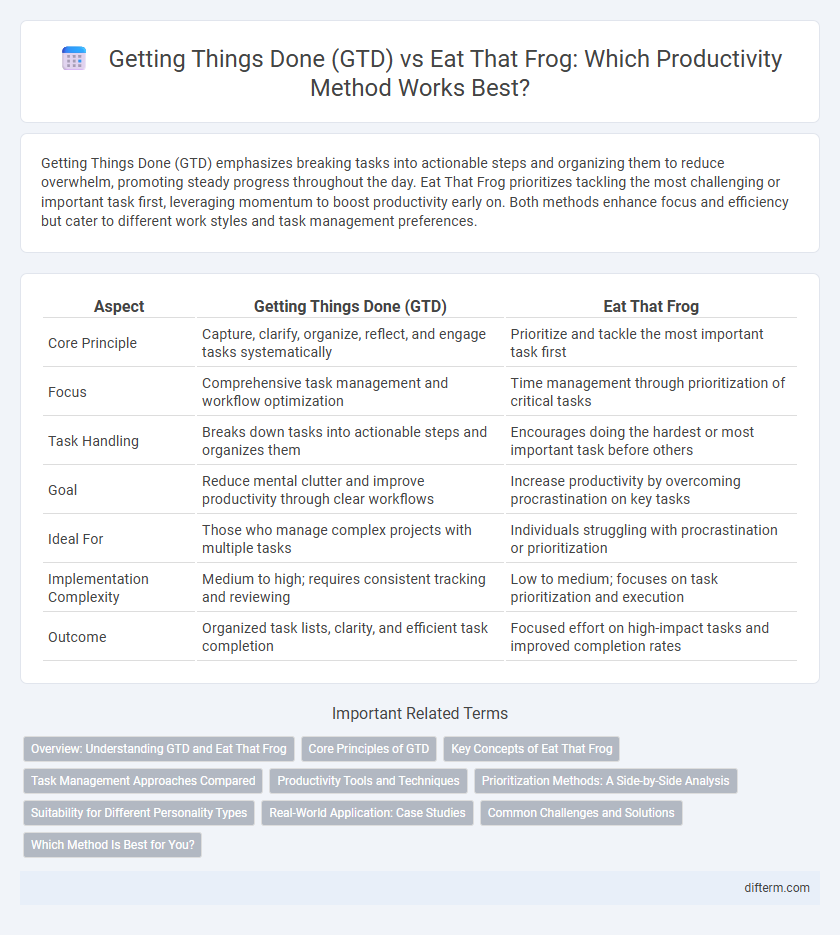Getting Things Done (GTD) emphasizes breaking tasks into actionable steps and organizing them to reduce overwhelm, promoting steady progress throughout the day. Eat That Frog prioritizes tackling the most challenging or important task first, leveraging momentum to boost productivity early on. Both methods enhance focus and efficiency but cater to different work styles and task management preferences.
Table of Comparison
| Aspect | Getting Things Done (GTD) | Eat That Frog |
|---|---|---|
| Core Principle | Capture, clarify, organize, reflect, and engage tasks systematically | Prioritize and tackle the most important task first |
| Focus | Comprehensive task management and workflow optimization | Time management through prioritization of critical tasks |
| Task Handling | Breaks down tasks into actionable steps and organizes them | Encourages doing the hardest or most important task before others |
| Goal | Reduce mental clutter and improve productivity through clear workflows | Increase productivity by overcoming procrastination on key tasks |
| Ideal For | Those who manage complex projects with multiple tasks | Individuals struggling with procrastination or prioritization |
| Implementation Complexity | Medium to high; requires consistent tracking and reviewing | Low to medium; focuses on task prioritization and execution |
| Outcome | Organized task lists, clarity, and efficient task completion | Focused effort on high-impact tasks and improved completion rates |
Overview: Understanding GTD and Eat That Frog
Getting Things Done (GTD) is a productivity method developed by David Allen that emphasizes capturing, clarifying, organizing, reflecting, and engaging with tasks to increase efficiency. Eat That Frog, created by Brian Tracy, focuses on time management by prioritizing and completing the most challenging or important task first to overcome procrastination. Both systems aim to improve productivity but differ in approach: GTD provides a structured workflow for task management, while Eat That Frog zeroes in on tackling high-impact tasks to maximize results.
Core Principles of GTD
Getting Things Done (GTD) centers on capturing all tasks in a trusted system, clarifying next actions, and regularly reviewing priorities to maintain workflow efficiency. Its core principles emphasize organizing tasks by context and breaking projects into actionable steps, enabling clearer focus and reduced mental clutter. GTD's structured approach contrasts with the Eat That Frog method, which prioritizes tackling the most challenging task first to overcome procrastination quickly.
Key Concepts of Eat That Frog
Eat That Frog emphasizes prioritizing tasks by tackling the most challenging and important ones first to maximize productivity. It encourages using the 80/20 rule, focusing on the few critical tasks that yield the highest results. Time blocking and eliminating distractions are key strategies to maintain focus and ensure completion of top-priority activities.
Task Management Approaches Compared
Getting Things Done (GTD) emphasizes capturing all tasks in a trusted system, breaking them into actionable steps and organizing by context to reduce cognitive load and increase focus. Eat That Frog prioritizes tackling the most important or challenging task first each day, promoting discipline and preventing procrastination through focused action on high-impact activities. Both methods improve productivity but GTD offers comprehensive task organization, while Eat That Frog concentrates on prioritization and execution of key tasks.
Productivity Tools and Techniques
Getting Things Done (GTD) utilizes a comprehensive workflow system centered on task capturing, clarifying, organizing, reflecting, and engaging to enhance productivity through detailed project management. Eat That Frog emphasizes prioritization by tackling the most challenging and important task first, leveraging time-blocking and focus strategies to boost efficiency. Both methods integrate productivity tools such as digital to-do lists, calendars, and reminders, but GTD offers a broader organizational framework, whereas Eat That Frog provides a streamlined, priority-driven technique.
Prioritization Methods: A Side-by-Side Analysis
Getting Things Done (GTD) emphasizes capturing tasks and organizing them into actionable lists to reduce mental clutter, while Eat That Frog prioritizes tackling the most important and challenging task first to maximize focus and efficiency. GTD uses a systematic workflow with defined contexts and next actions, whereas Eat That Frog relies on identifying and addressing the "frog" task to overcome procrastination. Both methods enhance productivity through structured prioritization but cater to different workflow preferences and task management strategies.
Suitability for Different Personality Types
Getting Things Done (GTD) offers a structured and detailed system that suits analytical and methodical personalities who thrive on organization and step-by-step planning. Eat That Frog appeals to individuals preferring a straightforward, priority-based approach, ideal for those who are goal-driven and motivated by quick decision-making. Choosing between GTD and Eat That Frog depends on whether the individual values comprehensive task management or a focused, action-oriented method for productivity.
Real-World Application: Case Studies
Getting Things Done (GTD) emphasizes structured task management through workflows, with real-world case studies showing enhanced project tracking and reduced mental clutter in corporate environments. Eat That Frog focuses on prioritizing the most challenging tasks first, demonstrated by professionals who report significant improvements in daily productivity and time management. Both methodologies have proven success across diverse industries, with GTD excelling in complex, multi-step projects and Eat That Frog boosting efficiency in deadline-driven settings.
Common Challenges and Solutions
Getting Things Done (GTD) and Eat That Frog both address productivity challenges like procrastination and task overload. GTD's solution lies in organizing tasks into actionable lists and contexts, easing cognitive load and enhancing focus, while Eat That Frog prioritizes tackling the most difficult or important task first to combat procrastination directly. Combining GTD's systematic approach with Eat That Frog's prioritization strategy offers a practical method to overcome overwhelm and improve time management.
Which Method Is Best for You?
Choosing between Getting Things Done (GTD) and Eat That Frog depends on your workflow and personal productivity style. GTD emphasizes comprehensive task organization and capturing every commitment, ideal for those juggling multiple projects and seeking structured clarity. Eat That Frog prioritizes tackling the most challenging or important task first, benefiting users who struggle with procrastination and need a straightforward approach to boost focus and momentum.
Getting Things Done (GTD) vs Eat That Frog Infographic

 difterm.com
difterm.com